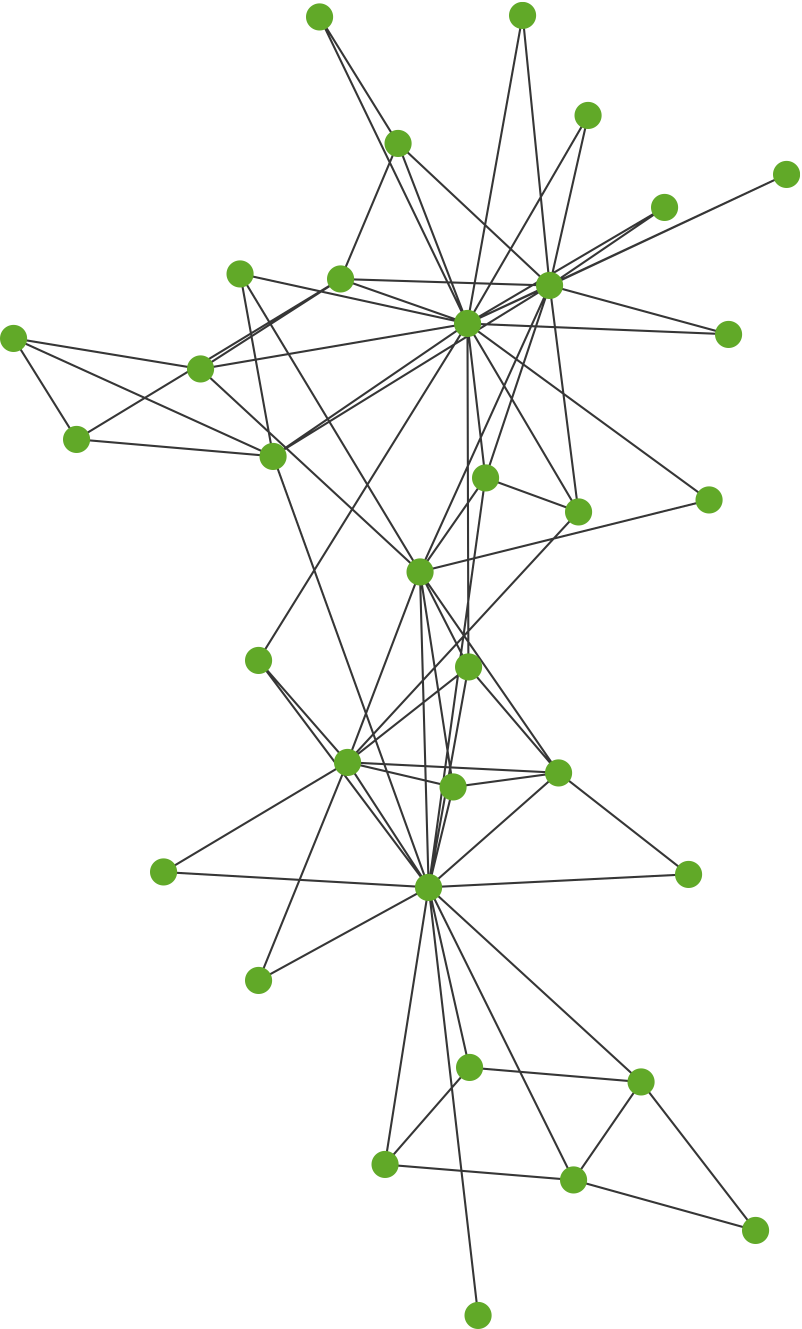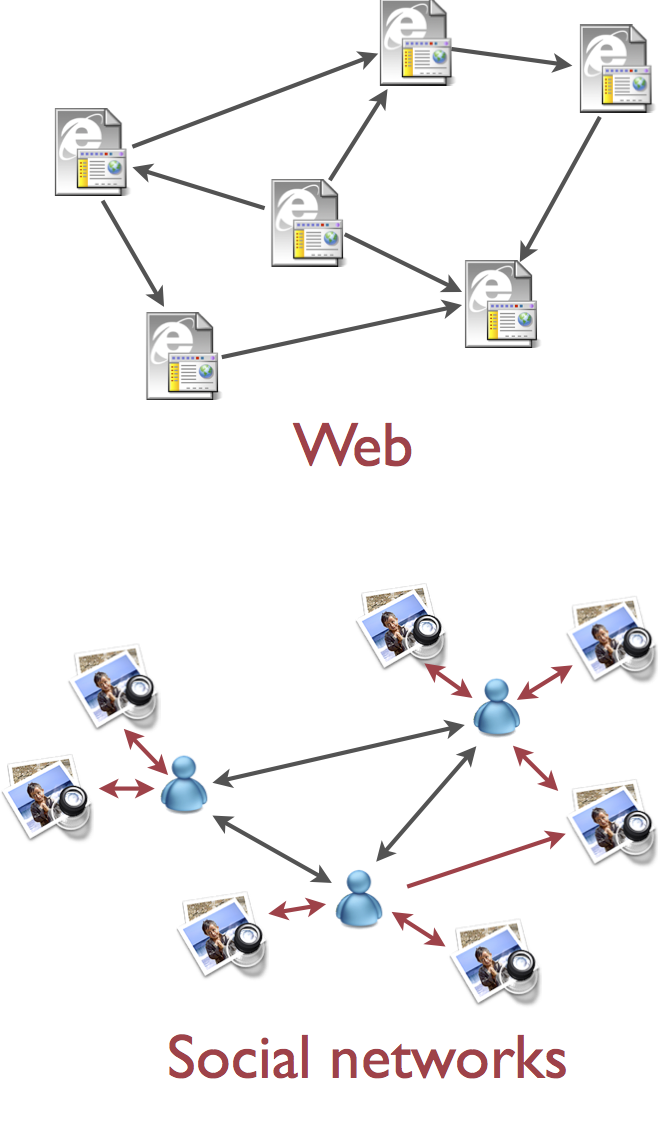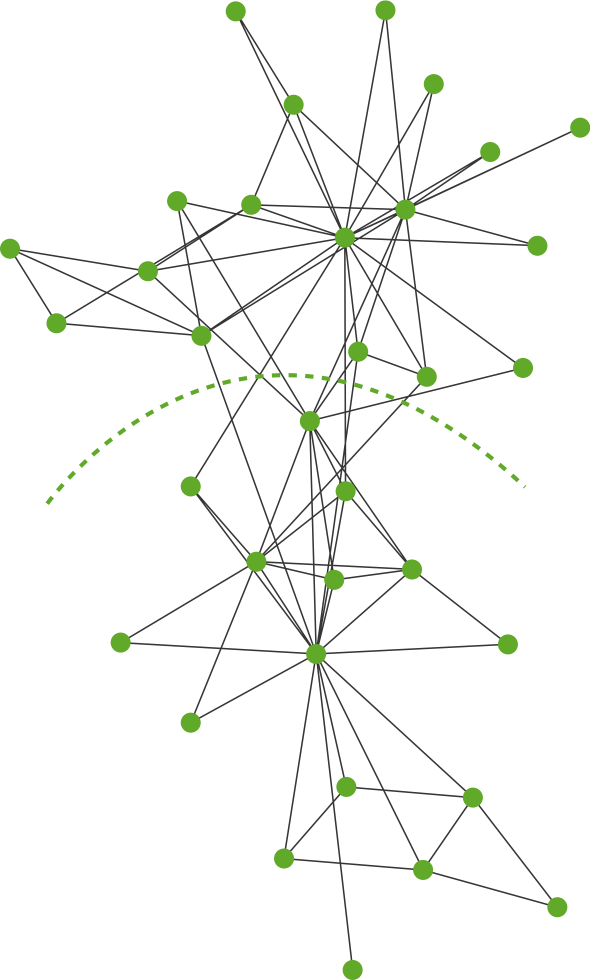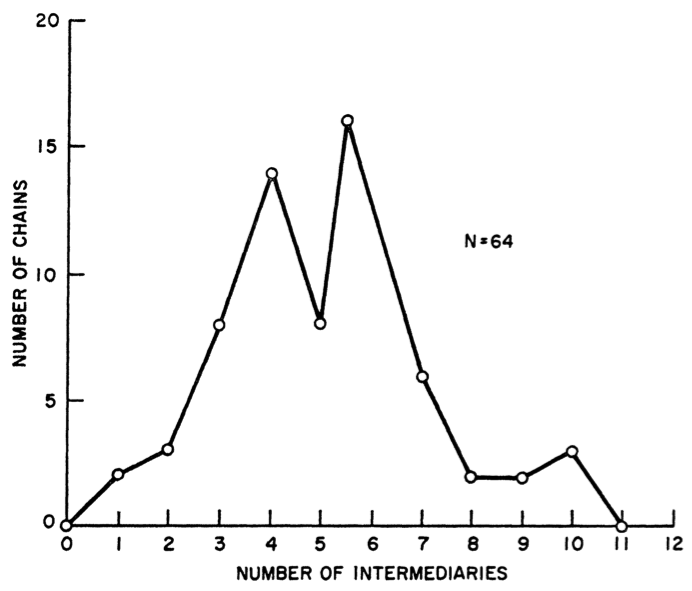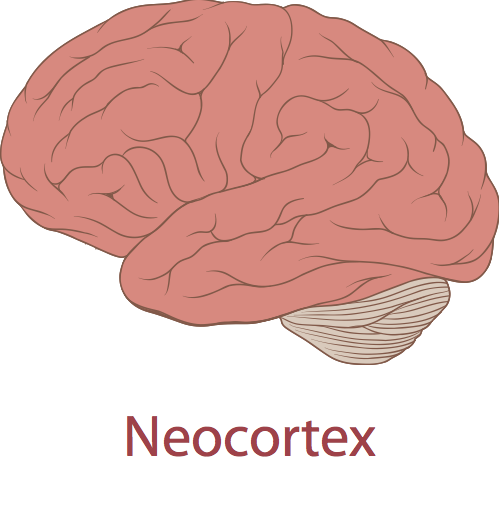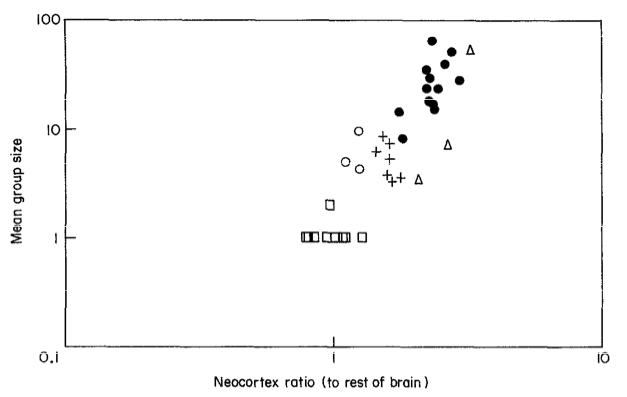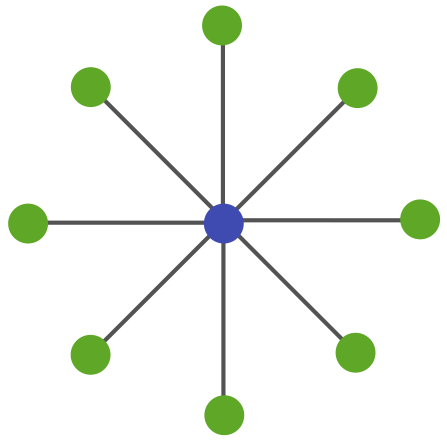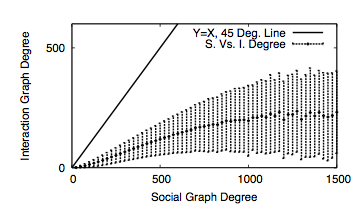Sociology background
What shapes social graphs?
Social media
- Social media has transformed society
- Reduced barriers to communication
- Democratized content publication
- As a computer scientist...
- Tend to ignore users
- Social media makes users a part of the system
Important to understand interactions
- Within the system (traditional CS)
- Between users and system (HCI)
- Among users themselves (sociology)
What is social media?
- Systems with user interaction as critical component
- Online communities
- Facebook, MySpace, YouTube
- Communication systems
- Social news media
- Online worlds
- World of WarCraft, Second Life
- Online marketplaces
Why is social media interesting?
- For social scientists?
- Two reasons (to me, as a computer scientist)
- 1. Observe social interaction at scale
- Social media based user interactions
- Scale not possible to study before
- Scale does not require less information per user
- 2. Relate information and people
- Online social networks now content-sharing systems
- Opportunities to understand relationship between the two
- Can attach reputation of users to content
1. Observe social interactions
- Anyone recognize this network?
- Collecting it involved massive field work
- Manually observe people
- Trace interactions for two years (!)
- Will discuss more later
- Limit in scalability of this approach
- Biases from interviewing
- Time spent
- Willingness of partcipants
- Observable data resolution
Opportunity: Large-scale data
- An opportunity to scale up observations
- “Field work” required may be reduced
- Social media sites have complete history record
- Interactions, discussions, friendship creation (and deletion), ...
- Entire evolution of a group of users
- Believe me, they keep logs of all of this
- At incredible detail
- 50% of Facebook users online on given day
- 500B people-minutes spent on Facebook each month
- Every interaction, page view, search, ... recorded
What scale has been studied before?
- 1977: 34 people in a Karate club
- Zachary, J. Anth. Res. 1972
- 2003: 436 people using a corporate email system
- Adamic and Adar, Social Networks 2003
- 2006: 43,553 people using a university email system
- Kossinets and Watts, Science 2006
- 2007: 4,400,000 people using an online blogging service
- Backstrom et al., KDD 2007
- 2009: 240,000,000 people using an instant messaging service
- Leskovec and Horvitz, WWW 2008
- 2011: 721,000,000 people using an social networking web site
The curse of scale
- Scale is both a blessing and a curse
- Blessing
- Confidence in results
- Easily test new hypotheses
- Certain effects only seen at scale
Curse
- Miss many local interactions
- Links “mean” less
- Comparing networks hard
- Hard to separate signal from noise
Important to keep limitations in mind
2. Relate information to people
- Popular way to connect and share content
- Photos, videos, blogs, profiles, news, status...
- Facebook (1.1 B), Sina Weibo (100s M)
- Growing exponentially
- Incredible amounts of content being shared
- Facebook (850 M photos/month)
- YouTube (48 hours of video/min)
- But, content organized differently...
A new way of organizing information
- Web organized with content-content links
- Link structure exploited (e.g., PageRank)
- But, social media organized using
- User-user links (social network)
- More user-user links (interactions)
- User-content links (favorites, etc)
- New platform for information sharing
- Resulting link structure very different from other studied networks
- As we observed in the previous lecture
- Why?
Relates information to people
- Today, social network used to structure information
- Can we extract other information?
- Combination of who and what very powerful
- Social network connects content with
- (Multiple) users' reputation
- Community the user is part of
- Can potentially be used to address new challenges
- Multiple identity (Sybil) attacks
- Phishing attacks
- Reputation manipulation in various forms
But why study networks?
- Does network science make sense for social media?
- Why not study interactions directly?
- Natural fit with social media sites
- Remember, networks are a way to represent interactions
- Users typically only interact with small subset of others
- Degrees of influence and effect beyond friends
- Obesity Fowler and Christakis, NE J. Med. 2007
- Altruism Fowler et al., Econ. Let. 2009
- Example: Zachary’s Karate Club
- Can predict behavior with network view Zachary, J. Anth. Res. 1972
In this lecture, what are we asking?
- Already know lots about networks
- Scale-free Barabasi and Albert, 1999, High clustering Watts and Strogatz, 1998, Navigable Adamic and Adar, 2003 Liben-Nowell 2005, Hubs and authorities Page and Brin, 1998 Kleinberg, 1999], Dense core Mislove et al. 2007
- And have lots of models
- Preferential Attachment Barabasi and Albert, Nature 1999, Small-world Watts and Strogatz, 1998, Copying Kleinberg et al., 1999, Congestion Mihail et al., 2003, Bowtie Broder et al., 2000, Jellyfish Tauro et al., 2001
- Today, going to focus on social aspects
- Why do networks look the way they do?
- What can this tell us? How can we leverage them?
The Strength of Weak Ties
Mark S. Granovetter
American Journal of Sociology, vol. 78 issue 6. May 1973
“Classical” sociology
- Focused on two topics
- Micro-level interactions within a small group
- Macro-level patterns within a society
- “Strong” ties considered the important ones
- Close friends, family
- “Weak” ties considered less important
- But, mapping not understood
- How do large-scale patterns emerge?
- How do small interactions build up, shape society?
- ...certain analogies to physics...
Granovetter’s idea
- Construct simple model:
- If two people have a common strong tie, they must have a tie between each other
- Matches intuition from real world
- If you have two close friends, they (at least) know each other
- What are the implications of this model?
Granovetter’s idea
- Social networks can be divided into communities
- Clubs, schools, employers, ...
- Communities generally consist of dense, strong ties
- Define a bridge as a link that is the only path between two users
- Claim: With Granovetter’s assumption, bridges must be weak
Importance of bridges
- Bridges connect communities
- Build up society from a set of communities
- Thus, weak ties (bridges) can help the micro \(\rightarrow\) macro mapping
- Bridges must necessarily carry any new information
- Example: People often find new jobs via weak ties
- Users with more weak ties have social "safety" net
- Societies with more weak ties better able to adapt
- Hence, the strength of weak ties
- But, what is the structure of weak ties at scale?
- Are the really necessary for conveying information?
Questions for consideration
- Do you believe Granovetter's hypothesis?
- How well does Granovetter's model map to the real world?
- How could we validate/invalidate Granovetter's idea?
- Does social media make it easier or harder?
- Are weak ties as relevant today, with communication being so cheap?
- Are social media sites changing the nature of ties?
- Given that information doesn't flow between people directly
An Experimental Study of the
Small World Problem
Jeffery Travers and Stanley Milgram
Sociometry, vol.32 no. 4. 1969
Six degrees of Kevin Bacon
- Six degrees of separation now common saying
- Popularized by this study
- At the time, sociologists had no idea of shortest path
- If asked, answers we typically around 100
- Assume 200M people, each with ~100 friends
- Expect 2-3 intermediaries
- But does not consider network structure
- High clustering increases path lengths
- What is the actual value?
- How to measure?
Procedure
- Selected 296 people in Nebraska and Boston
- Mailed a packet containing instructions
- Packet specified a destination person
- Name, address, profession, and city
- Asked to forward to someone known personally
- Send a card back to Milgram
- And add name to a roster
- Why?
How long are the (successful) paths?
Implications of six degrees
- Not only do short chains exist...
- But people can find them!
- With only local information
- (at the time, no Facebook, etc)
- Thus, social networks are navigable
- Users able to get information to a specific destination
- Social network properties useful for routing
- 40% of chains coalesced into 2 people
- Important structural properties
Questions for consideration
- How did users route?
- Did they rely on certain network properties?
- Did/do shorter paths exist?
- What are the limitations of this study?
- Why do you think this study became so popular?
- If Milgram repeated the exact same study today, what would the results be?
Bonus paper:
Neocortex Size as a Constraint
on Group Size in Primates
Robin I. M. Dunbar
Journal of Human Evolution, vol. 22. 1992
Neocortex
- Part of the brain of mammals, involved in
- Sensory perception
- Motor commands
- Spatial reasoning
- Thought and language
- Social interactions
- In hominids, represents 80% of brain by volume
- Theory: large brain size due to “social” nature of primates
- Measure “social” level by looking at typical group size
- If true, then brain size should correlate with being “social”
Neocortex size and group size
- Strong correlation observed
- Holds across many species of primates
Implications of neocortex limits
- Each individual can only maintain so many relationships
- Not just number of relationships, it’s the pairs (dyads)
- Who likes who, who doesn’t, etc
- Is this true for humans?
- Social groups are less well-defined
- Dunbar predicts value of 150 from neocortex size
Questions for consideration
- How could we measure Dunbar's number of humans?
- What about before Facebook existed?
- How could we validate Dunbar's hypothesis?
- Is social media affecting Dunbar's number? (yey, xkcd)
- What about different relationship types?
- What is the variance across individuals?
...Preview of Facebook study...


